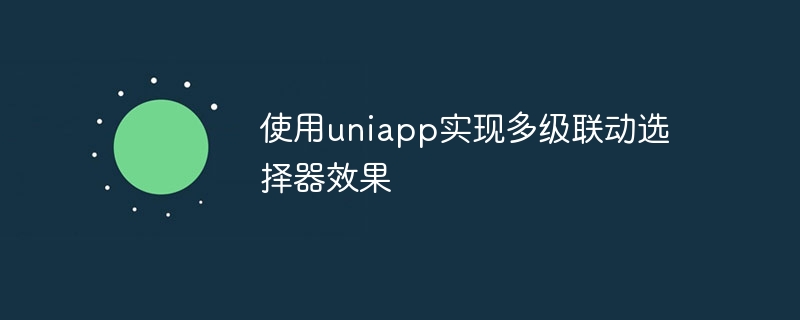使用uniapp實現多級連動選擇器效果

使用Uniapp實作多級連動選擇器效果
一、介紹
多級連動選擇器是一種常見的互動效果,在許多應用場景中都能看到。在Uniapp中,我們可以利用它提供的元件和API,輕鬆實現這種效果。本文將介紹如何使用Uniapp實作多級連動選擇器,並提供具體的程式碼範例。
二、準備工作
在開始實作之前,我們需要準備以下工作:
- #安裝Uniapp開發環境,包括Node.js、HBuilderX等;
- 建立Uniapp項目,選擇適合的範本;
- 了解Uniapp的基本開發知識,包括元件、頁面路由等。
三、實作步驟
- 建立選擇器的資料來源
多級連動選擇器的核心是資料來源,我們首先需要建立一組符合要求的數據。以三級連動選擇器為例,我們定義一個數組,數組的每個元素都是一個對象,對象包括一個顯示文字和一個子級數組。而子級數組也是由物件組成,依此類推。
例如,我們建立一個省市區資料來源:
const data = [
{
name: '北京市',
children: [
{
name: '东城区',
children: [
{ name: '东华门街道' },
{ name: '东四街道' }
]
},
{
name: '西城区',
children: [
{ name: '西单街道' },
{ name: '西直门街道' }
]
}
]
},
{
name: '上海市',
children: [
{
name: '黄浦区',
children: [
{ name: '外滩街道' },
{ name: '南京东路街道' }
]
},
{
name: '徐汇区',
children: [
{ name: '徐家汇街道' },
{ name: '田林街道' }
]
}
]
}
];- #實作頁面結構和樣式
在Uniapp中,我們可以使用它提供的元件進行頁面的搭建。首先,在pages目錄下建立一個名為index的頁面,在index.vue檔案中寫頁面結構和樣式。
<template>
<view class="container">
<!-- 一级选择器 -->
<picker mode="selector" :range="{{provinceList}}" bindchange="handleProvinceChange" :value="provinceIndex">
<view class="picker-block">
<text>请选择省份</text>
<text>{{provinceName}}</text> <!-- 显示选择的省份 -->
</view>
</picker>
<!-- 二级选择器 -->
<picker mode="selector" :range="{{cityList}}" bindchange="handleCityChange" :value="cityIndex">
<view class="picker-block">
<text>请选择城市</text>
<text>{{cityName}}</text> <!-- 显示选择的城市 -->
</view>
</picker>
<!-- 三级选择器 -->
<picker mode="selector" :range="{{districtList}}" bindchange="handleDistrictChange" :value="districtIndex">
<view class="picker-block">
<text>请选择区县</text>
<text>{{districtName}}</text> <!-- 显示选择的区县 -->
</view>
</picker>
</view>
</template>
<style>
.container {
display: flex;
flex-direction: column;
align-items: center;
justify-content: center;
height: 100vh;
}
.picker-block {
margin-bottom: 20px;
}
</style>- 實作選擇器的事件處理
在Uniapp中,我們可以使用picker元件的bindchange事件來監聽選擇器的變化,並執行對應的邏輯。
在index.vue檔案中加入以下程式碼:
<script>
export default {
data() {
return {
provinceList: [],
provinceIndex: 0,
provinceName: "",
cityList: [],
cityIndex: 0,
cityName: "",
districtList: [],
districtIndex: 0,
districtName: ""
};
},
mounted() {
this.initData();
},
methods: {
initData() {
// 初始化省份列表
this.provinceList = data.map(item => item.name);
// 初始化城市列表
this.handleProvinceChange({ detail: { value: this.provinceIndex } });
},
handleProvinceChange(e) {
const index = e.detail.value;
this.provinceIndex = index;
this.provinceName = this.provinceList[index];
// 根据选择的省份,初始化城市列表
const cityData = data[index].children;
this.cityList = cityData.map(city => city.name);
// 初始化区县列表
this.handleCityChange({ detail: { value: this.cityIndex } });
},
handleCityChange(e) {
const index = e.detail.value;
this.cityIndex = index;
this.cityName = this.cityList[index];
// 根据选择的城市,初始化区县列表
const districtData = data[this.provinceIndex].children[index].children;
this.districtList = districtData.map(district => district.name);
// 初始化选中的区县
this.handleDistrictChange({ detail: { value: this.districtIndex } });
},
handleDistrictChange(e) {
const index = e.detail.value;
this.districtIndex = index;
this.districtName = this.districtList[index];
}
}
};
</script>四、執行與偵錯
在HBuilderX中,選擇合適的運行環境,可以在模擬器或真機上預覽和調試。如果一切正常,就可以看到多級連動選擇器的效果了。
五、總結
本文介紹了使用Uniapp實作多級連動選擇器的方法,包括建立資料來源、實作頁面結構和樣式、以及處理選擇器的事件。透過這些步驟,我們可以輕鬆地在Uniapp中實現多級連動選擇器的效果。希望本文對Uniapp開發有幫助!
以上是使用uniapp實現多級連動選擇器效果的詳細內容。更多資訊請關注PHP中文網其他相關文章!

熱AI工具

Undresser.AI Undress
人工智慧驅動的應用程序,用於創建逼真的裸體照片

AI Clothes Remover
用於從照片中去除衣服的線上人工智慧工具。

Undress AI Tool
免費脫衣圖片

Clothoff.io
AI脫衣器

Video Face Swap
使用我們完全免費的人工智慧換臉工具,輕鬆在任何影片中換臉!

熱門文章

熱工具

記事本++7.3.1
好用且免費的程式碼編輯器

SublimeText3漢化版
中文版,非常好用

禪工作室 13.0.1
強大的PHP整合開發環境

Dreamweaver CS6
視覺化網頁開發工具

SublimeText3 Mac版
神級程式碼編輯軟體(SublimeText3)
 webstorm開發uniapp專案如何啟動預覽
Apr 08, 2024 pm 06:42 PM
webstorm開發uniapp專案如何啟動預覽
Apr 08, 2024 pm 06:42 PM
在 WebStorm 中啟動 UniApp 專案預覽的步驟:安裝 UniApp 開發工具外掛程式連接到裝置設定 WebSocket啟動預覽
 uniapp和mui哪個好
Apr 06, 2024 am 05:18 AM
uniapp和mui哪個好
Apr 06, 2024 am 05:18 AM
整體而言,需複雜原生功能時,uni-app 較好;需簡單或高度自訂介面時,MUI 較好。此外,uni-app 具備:1. Vue.js/JavaScript 支援;2. 豐富原生組件/API;3. 良好生態系。缺點是:1. 效能問題;2. 客製化介面困難。 MUI 具備:1. Material Design 支援;2. 高度彈性;3. 廣泛元件/主題庫。缺點是:1. CSS 依賴;2. 不提供原生元件;3. 生態系較小。
 uniapp有什麼缺點
Apr 06, 2024 am 04:06 AM
uniapp有什麼缺點
Apr 06, 2024 am 04:06 AM
UniApp 作為跨平台開發框架擁有許多便利,但缺點也較為明顯:效能受限於混合開發模式,導致開啟速度、頁面渲染和互動回應較差。生態系統不完善,特定領域組件和庫較少,限制創意發揮和複雜功能實現。不同平台的相容性問題,易出現樣式差異和 API 支援不一致的情況。 WebView 的安全機制不同於原生應用,可能降低應用程式安全性。同時支援多個平台的應用程式發布更新需要多次編譯打包,增加開發和維護成本。
 uniapp和flutter有什麼差別
Apr 06, 2024 am 04:30 AM
uniapp和flutter有什麼差別
Apr 06, 2024 am 04:30 AM
UniApp 基於 Vue.js,Flutter 基於 Dart,兩者都支援跨平台開發。 UniApp 提供豐富的元件和簡易開發,但效能受限於 WebView;Flutter 使用原生渲染引擎,效能優異,但開發難度較高。 UniApp 擁有活躍的中文社區,Flutter 擁有龐大且全球化的社區。 UniApp 適合快速開發、效能要求不高的場景;Flutter 適合客製化程度高、高效能的複雜應用。
 uniapp用什麼開發工具
Apr 06, 2024 am 04:27 AM
uniapp用什麼開發工具
Apr 06, 2024 am 04:27 AM
UniApp使用HBuilder X作為官方開發工具,該IDE整合了程式碼編輯器、偵錯器、模擬器和豐富的插件,為跨平台行動應用程式開發提供全面的支援。
 學uniapp需要哪些基礎
Apr 06, 2024 am 04:45 AM
學uniapp需要哪些基礎
Apr 06, 2024 am 04:45 AM
uniapp開發需要以下基礎:前端技術(HTML、CSS、JavaScript)行動開發知識(iOS和Android平台)Node.js其他基礎(版本控制工具、IDE、行動開發模擬器或真機除錯經驗)
 uniapp和原生開發哪個好
Apr 06, 2024 am 05:06 AM
uniapp和原生開發哪個好
Apr 06, 2024 am 05:06 AM
在 UniApp 和原生開發之間選擇時,應考慮開發成本、效能、使用者體驗和靈活性。 UniApp 優點在於跨平台開發、快速迭代、易於學習和內建插件,而原生開發則在效能、穩定性、原生體驗和可擴展性方面更勝一籌。根據特定專案需求權衡利弊,初學者適合 UniApp,追求高效能和無縫體驗的複雜應用程式適合原生開發。
 uniapp開發小程式用什麼元件庫
Apr 06, 2024 am 03:54 AM
uniapp開發小程式用什麼元件庫
Apr 06, 2024 am 03:54 AM
uniapp 開發小程式推薦的元件庫:uni-ui:uni 官方出品,提供基礎和業務元件。 vant-weapp:位元組跳動出品,擁有簡潔美觀 UI 設計。 taro-ui:京東出品,基於 Taro 框架開發。 fish-design:百度出品,採用 Material Design 設計風格。 naive-ui:有讚出品,現代化 UI 設計,輕量易客製化。






